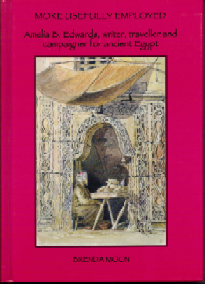
Egypt in England Newsletter
2015
January
The Mystery of Lot 279
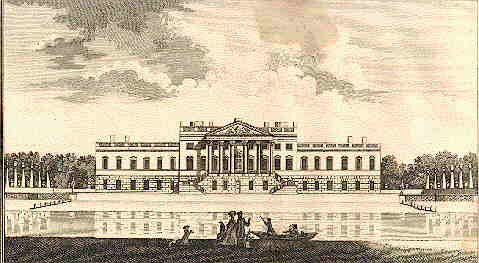
Wanstead House (Wikimedia Commons)
In the summer and autumn of 1822, when the contents of Wanstead House were sold at auction to meet the crippling debts run up by William Pole-
“A ditto [another stone pedestal] with curious Egyptian stone ornament on the top, sculptured in hieroglyphs.”
The “ornament” was actually a pyramidion, the pyramid shaped capstone from the tomb monument of Tia, a brother-
Smart was a celebrated antiquarian, and had became a Fellow of the Society of Antiquaries in 1724. In 1737 the Secretary to the Society of Antiquaries (and occasional operatic tenor) Alexander Gordon published An Essay toward explaining the Hieroglyphical Figures on the Coffin of the Ancient Mummy belonging to Capt. William Lethieullier. This work also illustrated the pyramidion of Tia, which was by then in the possession of Smart, and means that we have a very good idea what it looked like.
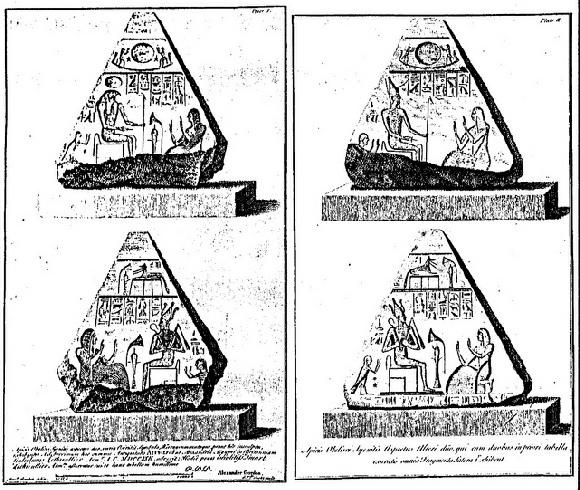
(Courtesy of Ralph Potter)
Smart, the owner of Aldersbrook House in Essex, died in 1760, and although he bequeathed both the pyramidion and the naos to the British Museum, they never reached it. He was friendly with his neighbour at Wanstead House, John, 2nd Earl Tylney, who shared his interest in antiquities, and both pieces may have been loaned or given to Tylney during Smart's lifetime, or been acquired when the manor and lands of Aldersbrook were purchased in 1786 by Sir James Tylney Long from Mary, the daughter of Smart's sister-
However it got there, we know that the pyramidion was in the gardens at Wanstead House in 1792, as it was described by the Danish antiquarian Georg Zoëga in his book on Egyptian obelisks De Origine usu Obeliscorum. The owner of Wanstead House at that time, Sir James Tylney Long, nephew of John Tylney, died in 1794 and was succeeded by his son, also called James, who died aged 11. The estate then passed to his sister Catherine, who became one of the richest, and most eligible, heiresses of her day. In 1812 she married William Pole-
Several catalogues for the sale at Wanstead House have survived, and one is marked with the prices and buyers of many lots, but has nothing for Lot 279 apart from a cryptic note suggesting that it may have been among items held over to another day for lack of time. A second sale was indeed held, of lots "deferred at the late sale, together with various uncleared lots", but there are no known annotated copies of the second catalogue. Then the pyramidion vanishes. In 1882 the clergyman and collector Rev. Greville John Chester wrote to Samuel Birch, then Keeper of Oriental Antiquities at the British Museum, to say that he had seen "a very curious basalt pyramidion" in the Oxford Street shop of the antiquities dealer David Jewell, and describing it in terms which correspond with the engraving in Gordon's work. Chester urged Birch to view the pyramidion "before it is snapped up", but if Birch did he failed to secure it, and if it was the pyramidion of Tia its whereabouts is now unknown. Other than this tantalising clue, there has been no trace of it, from that day to this.
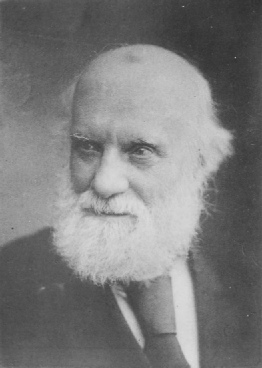 Then, in May 2013, a chance conversation between myself and Ralph Potter of the Friends of Wanstead Park was followed by someone asking him about a mysterious granite stone embedded in the bank of the Heronry Pond, and used as an Ordnance Survey benchmark, raising the tantalising possibility that this might be the long-
Then, in May 2013, a chance conversation between myself and Ralph Potter of the Friends of Wanstead Park was followed by someone asking him about a mysterious granite stone embedded in the bank of the Heronry Pond, and used as an Ordnance Survey benchmark, raising the tantalising possibility that this might be the long-
Meanwhile, however, there was to be yet another twist in the story. In May 2014 another copy of the Wanstead House sale catalogue emerged. This, unusually, had ruled interleaved pages with columns for pounds, shillings and pence, thicker covers, and gilded page edges. It had only one annotation – for Lot 279.
Samuel Birch (Wikimedia Commons)
“Brought from Egypt by Col. Lord Tilney [sic] and presented by Mr Robins to Thomas Bramall and now in garden at Tamworth.”
The auctioneers for the sale were Messrs Robins, father and son, and Robins senior, who had acquired Tamworth Castle in settlement of a debt, restored it for his son-
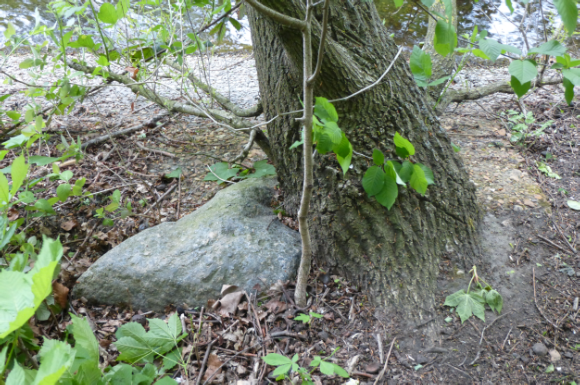
The Heronry Pond stone (courtesy of Ralph Potter)
Later in January this year, the Heronry Pond stone will at last be excavated. Most likely, what will emerge will be simply a lump of granite. Except that... an expert opinion on the portion currently above ground suggested that it was not, as might be expected, Aberdeen granite, but a granite from Aswan in Egypt. So it might, just possibly, be the long-
Until next time,
Ankh Wedja Seneb
Chris
February
The Mystery of Lot 279 -
What is archaeology about? It seems that in the popular imagination, an archaeologist is Indiana Jones or Lara Croft, unearthing hidden treasures and ancient artefacts.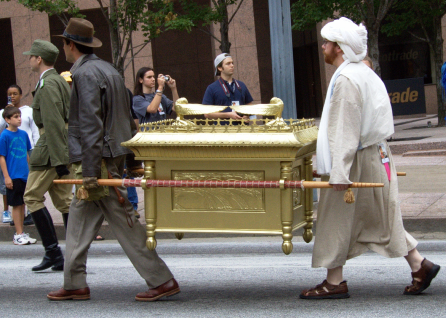
(Image courtesy of Michael Neel.)
It's all about danger, derring-
On January 22nd, members of the West Essex Archaeology Group excavated the mysterious stone in Wanstead Park. (See last issue.) The day was bright and dry, if cold, and we had not one, but two Egyptologists present, in the shape of Chris Naunton, Director of the Egypt Exploration Society, and Geoffrey Martin, Emeritus Edwards Professor of Egyptology at University College London. It would be wonderful to describe how, as the topsoil was removed, and the stone delicately scraped clear with trowel and brush, the outlines of carved reliefs and incised hieroglyphs began to emerge. Unfortunately, they didn't. The Heronry Pond stone was definitely not the lost Pyramidion of Tia. Not even in a battered and mutilated state.
So was the whole exercise a waste of time? Only if you subscribe to the treasure hunting view of archaeology. Because ultimately it wasn't about an artefact, it was about information. Even a once in a lifetime discovery, like the tomb of Tutankhamun, is about more than Carter's "gold -
In this case it was about what we didn't find, and the questions we asked as a result. At the end of the Sherlock Holmes story 'Silver Blaze', the following exchange takes place between Holmes and Inspector Gregory:
"Inspector Gregory: ‘Is there any other point to which you would wish to draw my attention?’
Sherlock Holmes: ‘To the curious incident of the dog in the night time.’
Inspector Gregory: ‘The dog did nothing in the night time.’
‘That was the curious incident,’ remarked Sherlock Holmes."
(© Chris Elliott 2015)
ABE Commemorated
Elsewhere in London, March 19th should see the long-
Until next time,
Ankh Wedja Seneb
Chris
March
Honouring Amelia
Seven years is a long time, but on Thursday 19th March a process that had started in 2008 finally came to its conclusion at 19 Wharton Street in Islington, when an English Heritage Blue Plaque honouring Amelia Edwards was unveiled. The scheme has been run in various incarnations since 1866 by the Royal Society of Arts, the London County Council, the Greater London Council, and since 1986 by English Heritage. In that time, nearly 900 plaques (all known as Blue Plaques, even though some of them aren't blue) have been set into buildings all across London, but only two of them commemorated Egyptologists. The first, erected by the London County Council in 1954 at 5 Cannon Place NW3, was for Abu Bagousheh, the Father of Pots, better known as the pioneer of modern Egyptology Sir Flinders Petrie. It was not until 1999 that the second, at 19 Collingham Gardens SW5, marked a London residence of Howard Carter, excavator of the tomb of Tutankhamun. I may be biased, but two Egyptologists out of a total of nearly 900 plaques in 142 years didn't seem excessive to me, and so I proposed Amelia Edwards for one.
 Amelia Ann Blandford Edwards, known to friends and family as Amy, and to colleagues as ABE, was a remarkable woman. She was a talented singer and musician, and could have practised either or both professionally, but after breaking off an early engagement because "although he loved me very much I could not really love him"1 she remained unmarried, and was instead to pursue a very successful career as a professional writer. Literary tastes have changed, and her novels and short stories are little read now, and then probably mostly by academics, but in her day she sold well, and some of her ghost stories in particular are still anthologised. She also wrote and edited non-
Amelia Ann Blandford Edwards, known to friends and family as Amy, and to colleagues as ABE, was a remarkable woman. She was a talented singer and musician, and could have practised either or both professionally, but after breaking off an early engagement because "although he loved me very much I could not really love him"1 she remained unmarried, and was instead to pursue a very successful career as a professional writer. Literary tastes have changed, and her novels and short stories are little read now, and then probably mostly by academics, but in her day she sold well, and some of her ghost stories in particular are still anthologised. She also wrote and edited non-
Famously, it was a visit to Egypt when she was forty-
"Standing there close against the base of it [the Great Pyramid]; touching it; measuring her own height against one of its lowest blocks; looking up all the stages of that vast, receding, rugged wall, which leads upward like an Alpine buttress and seems almost to touch the sky, the Writer suddenly became aware that these remote dates had never presented themselves to her mind until this moment as anything but abstract numerals. Now, for the first time, they resolved themselves into something concrete, definite, real. They were no longer figures, but years with their changes of season, their high and low Niles, their seed-
As well as seeing the surviving monuments of Ancient Egypt, and carrying out a modest excavation with her companions at Abu Simbel, she also witnessed the damage and destruction being caused to the antiquities by the drive to transform Egypt into a modern industrial nation on the European model. From this point on, the preservation, scientific excavation and accurate recording of the remains of Ancient Egypt became her mission. With the support of R S Poole of the British Museum, and Sir Erasmus Wilson, who was also instrumental in bringing Cleopatra's Needle to London, she founded the Egypt Exploration Fund, which eventually became the Egypt Exploration Society. Sacrificing her own writing career, she became Secretary of the Fund, and a tireless promoter of its aims through articles in popular magazines and scholarly journals, later touring the USA to lecture there. The Fund's excavations were instrumental in launching the careers of both Flinders Petrie and Howard Carter, and today the society that she helped found is doing the same for early career Egyptologists through its Centenary Fund. After her death, her will left her library and Egyptian antiquities collection to University College London, and funds to establish the first chair in Egyptian Archaeology and Philology in England there, the Edwards Professorship.
At the Blue Plaque unveiling ceremony, which was introduced by Professor Sir Christopher Frayling, a member of the Blue Plaque Committee, and also the author of 'The Face of Tutankhamun', the other speakers were the Emeritus Edwards Professor at UCL, Geoffrey Thorndike Martin, Professor Joanne Fletcher, Director of the Egypt Exploration Society Dr Chris Naunton, and papyrologist and Society Trustee Dr Margaret Mountford, who pulled the cord to unveil the plaque.
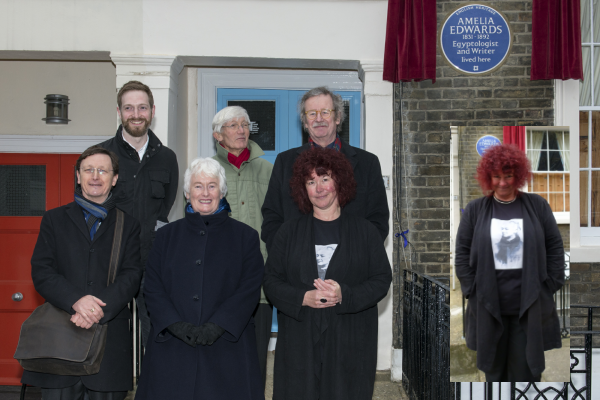
(Left to right, back row, Dr Chris Naunton, Prof. Geoffrey Martin and Prof. Sir Christopher Frayling, front Chris Elliott, Dr Margaret Mountford, Prof. Joanne Fletcher. Inset, Prof. Fletcher in ‘Team Amelia’ t-
Brenda Moon's biography of Amelia Edwards, 'More Usefully Employed', is available from the Egypt Exploration Society at the very reasonable price of £5. Click on the cover image to find out more, and if you aren't already a member of the Egypt Exploration Society, consider becoming one, and helping to preserve the legacy of a woman who achieved so much in a very practical way.
Until next time,
Ankh Wedja Seneb
Chris
1. Quoted in 'More Usefully Employed', Brenda Moon, p. 14
2. 'A Thousand Miles Up The Nile', Amelia Edwards, p. 2
3. 'A Thousand Miles Up The Nile', Amelia Edwards, p.15
April
From An Antique Vase...
Myths about Ancient Egypt are extraordinarily persistent, perhaps, as one commentator observed, because they are "interesting, coherent, and easily expressed". They not only seem to endure for ever, but they are also remarkably pervasive, linking all sorts of different groups within a culture. What Egyptian connection, for example, could link the scientist Michael Faraday with Mrs Beeton (of Book of Household Management fame), a Nobel Prize-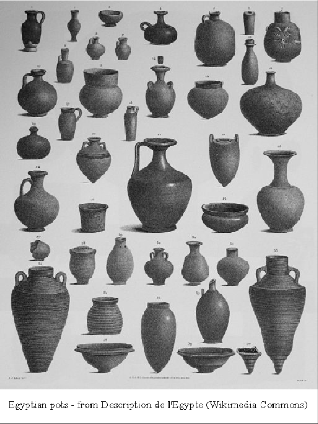 The story goes back to the first half of the nineteenth century, and two pioneers of the newly emerging discipline of Egyptology. One was Sir J G Wilkinson, who has a good claim to be the founder of British Egyptology, and the other was Thomas Pettigrew, author of the first comprehensive modern study of mummification, and probably the foremost unroller of Egyptian mummies. Wilkinson had presented to the British Museum "an antique vase, hermetically closed, which he had found in a mummy pit in Egypt, and the age of which was computed at about three thousand years". Pettigrew attempted to open it, but this resulted in the vase breaking into pieces. Inside was "a mass of vegetable dust", but also a few grains of wheat and a number of rock hard shrivelled peas. Pettigrew distributed the grains "among a few of his learned friends", who tried planting them to see if they would grow. Their efforts were in vain, as they simply rotted away. But that was not the end of the story.
The story goes back to the first half of the nineteenth century, and two pioneers of the newly emerging discipline of Egyptology. One was Sir J G Wilkinson, who has a good claim to be the founder of British Egyptology, and the other was Thomas Pettigrew, author of the first comprehensive modern study of mummification, and probably the foremost unroller of Egyptian mummies. Wilkinson had presented to the British Museum "an antique vase, hermetically closed, which he had found in a mummy pit in Egypt, and the age of which was computed at about three thousand years". Pettigrew attempted to open it, but this resulted in the vase breaking into pieces. Inside was "a mass of vegetable dust", but also a few grains of wheat and a number of rock hard shrivelled peas. Pettigrew distributed the grains "among a few of his learned friends", who tried planting them to see if they would grow. Their efforts were in vain, as they simply rotted away. But that was not the end of the story.
"It happened, however, that Mr Pettigrew kept three grains for curiosity sake, which, after the lapse of several years, he presented, as one of the greatest antiquities of the vegetable world, to Mr W Grimstone, the well-
Grimstone's Egyptian Pea
In June 1844 Grimstone planted the 'grains', which were actually peas, in "an artificial mould resembling, as nearly as possible, the alluvial soil of Egypt". After the application of "incredible care", after thirty days one of the peas sprouted. However, the resulting plant was "shrivelled, very weakly, almost without colour, and promised anything but a long life". All was not lost, though, as "Art came to the aid of nature", and after intensive care the plant was sturdy enough to be transplanted from the greenhouse into an outside bed. Here it matured, flowered, and produced its own peas, which when planted in turn "succeeded completely".
The quotes above are from the February 1849 issue of The Gardener, Florist, and Agriculturist, and the article goes on to reveal that Mr Grimstone, flushed with success, "addressed himself to Dr Plate, the secretary of the Syro-
The story of the Egyptian vase certainly seems to be based in fact, as Pettigrew referred to it in at least one of the lectures with which he accompanied his mummy unrollings, and a letter survives from J G Wilkinson to Pettigrew in which Wilkinson, intrigued by newspaper reports that some of the peas he had given Pettigrew had germinated, asks for more information, and at the same time provides confirmation that while unpacking items at the British Museum in 1833 or 1834 he had indeed given some seeds to Pettigrew.
It is not especially clear why several years later Pettigrew should have presented the three surviving peas to Mr Grimstone, if indeed he did, or what their connection was, but what is clear is that Grimstone was not only anxious that the public should be aware of his success, but that they should be able to repeat it themselves. We know from a newspaper advertisement that the owner of the Highgate Herbary sold his 'Egyptian Pea' in signed and sealed bags, including reproductions of two letters by J G Wilkinson (implying, but not stating, that they were on the topic of mummy peas) at half a crown a bag, boasting not only of the superior quality of the resulting crop, but that it would produce enough to supply a small family. This price, two shillings and sixpence, corresponds to about £8 in modern currency, and those of you who garden can compare this with what you usually pay for seeds. A cynic might also observe that in terms of a potential market, while few Victorian families grew wheat in their gardens, many grew peas. Grimstone himself was a purveyor of patent medicines, and seems to have been something of a chancer. A year after Plate's lecture he was declared bankrupt after being prosecuted for evasion of excise duty, although he did not go out of business as a result. Viewed in this light, it is not surprising that Plate's lecture reads like a recycled press release, and part of some opportunistic PR on Grimstone's part.
Vegetables From The Tomb
But what of Mummy Wheat? Surely this is more than dodgy marketing and PR? The earliest reference to Mummy Vegetables I am currently aware of is in The Times in 1832, which actually referred to a 'bulbous root', probably an onion, found in the hand of an Egyptian mummy, that had been successfully planted and grown, but the Gardener article notes that:
“At that time [presumably 1833-
 Certainly, by the 1840s the belief that wheat thousands of years old from Egyptian tombs had been grown successfully was widespread. A letter of January 1842 from the Orientalist Edward Lane to the traveller and collector Robert Hay reveals that Lane gave Wilkinson the corn said to have been found by Wilkinson in a mummy case “which has been so much puffed” (i.e. in the press), and mentions Hay's intention to try and germinate more of the same grain given by Lane to Hay. (BL Add Ms 38510 F.179) In June 1843 the celebrated scientist Michael Faraday, who examined material from Pettigrew's mummy unrollings, read to a meeting of the Royal Institution extracts from a note he had received from the writer and poet Martin Tupper on Tupper's allegedly successful planting of Mummy Wheat. By 1861 Mrs Isabella Beeton could note very matter-
Certainly, by the 1840s the belief that wheat thousands of years old from Egyptian tombs had been grown successfully was widespread. A letter of January 1842 from the Orientalist Edward Lane to the traveller and collector Robert Hay reveals that Lane gave Wilkinson the corn said to have been found by Wilkinson in a mummy case “which has been so much puffed” (i.e. in the press), and mentions Hay's intention to try and germinate more of the same grain given by Lane to Hay. (BL Add Ms 38510 F.179) In June 1843 the celebrated scientist Michael Faraday, who examined material from Pettigrew's mummy unrollings, read to a meeting of the Royal Institution extracts from a note he had received from the writer and poet Martin Tupper on Tupper's allegedly successful planting of Mummy Wheat. By 1861 Mrs Isabella Beeton could note very matter-
“The Egyptian, or Mummy Wheat, is not grown to any great extent, owing to its inferior quality; but it is notable for its large produce, and is often cultivated on allotment grounds and on small farms, where quantity rather than quality is desired.”
Book of Household Management Chap 35.
Baron Nettelbladt's Electric Apparatus and the Bearded Russian
Despite the widespread belief that seeds, grains and bulbs from Ancient Egyptian tombs could be successfully grown thousands of years later, as early as January 1843 the Gentleman's Magazine confessed that it had been “somewhat sceptical about the sprouting of the corn of Misraim's land, preserved through countless ages”, while conceding that “Mr Pettigrew's experience goes far to remove our doubts.” By 1895, however, William Carruthers, head of the Botanical Department at the Natural History Museum in London, could acidly observe that:
“It would be no greater wonder to see the hardened and eviscerated mummy, under favourable treatment, rise up and walk, than to see the grains found in its cerements germinate.”
(Nature Notes, 1895)
Many, however, would have pointed out what they felt to be unarguable proof to the contrary – that they had planted and grown seed taken from tombs and the cases and wrappings of mummies. The explanation for this, put forward in 1922 in the Guide to the Egyptian Rooms at the British Museum, was that Ancient Egyptian tombs were used by modern Egyptians to store wheat, which would germinate if not too old. There are also examples of mummies in transit being stored in stable buildings, where they could also easily be contaminated in this way.
In September 1934 Wallis Budge, previously Keeper of Egyptian and Assyrian Antiquities at the British Museum, did his best to dispel what he described as “hundred year old nonsense about mummy wheat'” by offering to “responsible” institutions for germination experiments samples of wheat taken from a 19th Dynasty tomb which he had excavated in 1906. Those taking him up on the offer included the National Institute of Agricultural Botany in Cambridge, and Farmer's Weekly. They also included one Baron Nettelbladt, who noted in a letter to Budge that “I have a large ultra-
Still, however, the myth of mummy wheat refused to die, as a letter to Budge from a Canadian correspondent in Provost, Alberta shows
“The idea prevalent among many of the farmers of this province is that mummy wheat' produces crops of astonishingly high yield. Unscrupulous salesmen prey upon these misguided individuals accordingly, very often peddling to them, as 'mummy wheat' very inferior varieties of wheat similar to the bearded Russian variety. Naturally, these salesmen demand, and secure, very exorbitant prices for their wheat.”
Helping to perpetuate the vegetable mummy myth, the name of Mummy Pea seems to have been given to a variety of crown flowered pea, and unusual and exotic looking vegetables (including beetroot) could be described as 'Egyptian' in the 19th century. (Personal communication from Rebsie Fairholm, who grows 'rare breed' vegetables.)
Little Women, a Black Centaur, and Internet immortality
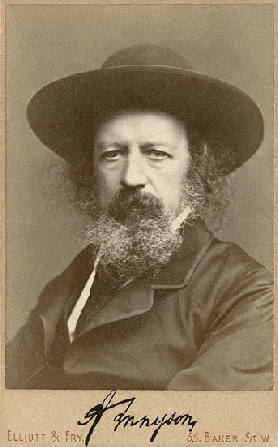 Writers and poets have helped to keep the myth alive as well. Lost in a Pyramid, an 1869 story by the author of Little Women, Louisa May Alcott, referred to wheat “taken from a mummy's coffin” that had sprouted and grown. In a poem to a friend, the Poet Laureate Alfred Lord Tennyson claimed that
Writers and poets have helped to keep the myth alive as well. Lost in a Pyramid, an 1869 story by the author of Little Women, Louisa May Alcott, referred to wheat “taken from a mummy's coffin” that had sprouted and grown. In a poem to a friend, the Poet Laureate Alfred Lord Tennyson claimed that
“...here the torpid mummy wheat
Of Egypt bore a grain as sweet
As that which gilds the glebe of England,
Sunned with a summer of milder heat.”
Later, William Butler Yeats, the Nobel Laureate, referred to mummy wheat in two poems, Conjunctions and On a picture of a black centaur by Edmund Dulac.
These literary uses suggest that a large part of the appeal of mummy wheat, peas, and even onions, stems from the association of Ancient Egypt with mystical longevity, and the power to preserve suspended life over millennia. In modern times, the ability of the Internet to assist the propagation of urban myths as well as scholarship probably means that despite all attempts to break the curse, nothing will stop the mummy vegetables rising from the tomb again...
For more on this topic, see the following
Grimstone and the Mummy Pea – Quack Doctor web site
The Seeds of Doom – Jasmine Day
Mummy Wheat -
Until next time,
Ankh Wedja Seneb
Chris
May
Egypt, Indirectly
What do you bring back when you travel abroad? Memories, certainly. What's the point of going otherwise? Most of us return with photos, and almost all of us bring back some other sort of souvenir. A recent trip to Rome made me think about these things, and how past visitors to the city have been part of the process by which Ancient Egypt has continued to influence us.
It is a process which has been going on for a long time. Rome's associations with the Apostle Peter, the early church and Christian martyrs, as well as its role as the seat of the papacy, have long made it one of the great sites of Christian pilgrimage, including pilgrims from the British Isles. Those with sufficient money or dedication could make the long and dangerous pilgrimage to the Holy Land and Jerusalem itself, often by way of Alexandria and sites in Egypt associated with the Flight of the Holy Family and various saints, but for others who could only go as far as Rome there were still reminders of Egypt and its associations with Christianity. Ordinary mortals bring back souvenirs. Caesars brought back imperial trophies, and foremost among these were obelisks from Egypt. Over the centuries those in Rome were toppled by man and the elements, but at least two remained upright for centuries after the fall of the Roman Empire. One of them was the obelisk brought back by Augustus in 10 BC, and set up in the Campus Martius (Field of Mars) as part of a giant solar meridian, marking the length of the days throughout the year. We know that it remained standing until at least the 8th century AD, as it was referred to then in the Einsiedeln Itinerary, a work which acted as a sort of guide book for pilgrims to Rome with a list of sites and directions. As it was one of the tallest obelisks in the city, it would have been a prominent landmark. Some time after that it fell, perhaps in an earthquake in 849 AD, or during the sack of Rome in 1084. Rediscovered in five pieces in 1512, an attempt was made to re-
Ordinary mortals bring back souvenirs. Caesars brought back imperial trophies, and foremost among these were obelisks from Egypt. Over the centuries those in Rome were toppled by man and the elements, but at least two remained upright for centuries after the fall of the Roman Empire. One of them was the obelisk brought back by Augustus in 10 BC, and set up in the Campus Martius (Field of Mars) as part of a giant solar meridian, marking the length of the days throughout the year. We know that it remained standing until at least the 8th century AD, as it was referred to then in the Einsiedeln Itinerary, a work which acted as a sort of guide book for pilgrims to Rome with a list of sites and directions. As it was one of the tallest obelisks in the city, it would have been a prominent landmark. Some time after that it fell, perhaps in an earthquake in 849 AD, or during the sack of Rome in 1084. Rediscovered in five pieces in 1512, an attempt was made to re-
Imperious Caesar…
The other obelisk to remain standing in Rome was its second tallest, now in Piazza San Pietro. When the Castilian traveller Pero Tafur visited in the 15th century, it was still in its original position on the site of the Vatican Circus, about 260 metres from where it now stands, to the left of the original basilica of St Peter. (See illustration.)

The obelisk, because of its position, was believed to mark the site of the martyrdom of St Peter, as well as other Christians killed in the Circus during Roman times. Its connection to the Roman emperors was preserved in the belief that the bronze globe on its peak held the ashes of Julius Caesar. Tafur referred to it as “Caesar's Needle”, and described it as a “three-
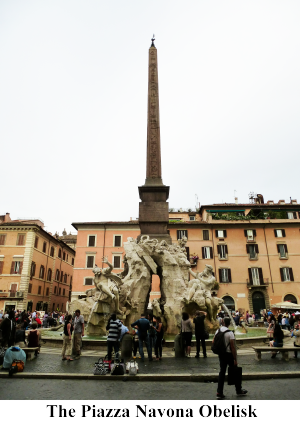 By the time of the Enlightenment, and the rise of the Grand Tour, souvenirs of a visit to Rome could be much more substantial. Wealthy dilettanti (or their agents) amassed collections of Classical, and sometimes Ancient Egyptian antiquities. Perhaps the ultimate obelisk souvenir, however, would have been that of Thomas Howard, Earl of Arundel, who travelled in Italy in 1613-
By the time of the Enlightenment, and the rise of the Grand Tour, souvenirs of a visit to Rome could be much more substantial. Wealthy dilettanti (or their agents) amassed collections of Classical, and sometimes Ancient Egyptian antiquities. Perhaps the ultimate obelisk souvenir, however, would have been that of Thomas Howard, Earl of Arundel, who travelled in Italy in 1613-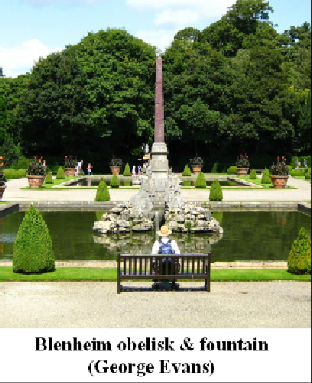
In 1710, John Churchill, 1st Duke of Marlborough, acquired a scaled down replica of the fountain and obelisk, begun by Bernini and completed after his death by his workshop, which now stands on the north terrace at Blenheim. You may object that this was only a replica, but so are many souvenirs. If you want authenticity, however, look no further than Dr John Bargrave, travelling tutor to the Grand Tourist John Raymond, who visited Italy in 1646-
Until next time,
Ankh Wedja Seneb
Chris
1 Pearce, S. 'Belzoni's Collection and the Egyptian Taste'. In C. Sicca and A. Yarrington eds. The Lustrous Trade: Material Culture and the History of Sculpture in England and Italy, c. 1760-
2 Chaney, Edward 'Roma Britannica and the cultural memory of Egypt: Lord Arundel and the obelisk of Domitian' in Roma Britannica: art patronage and cultural exchange in eighteenth-
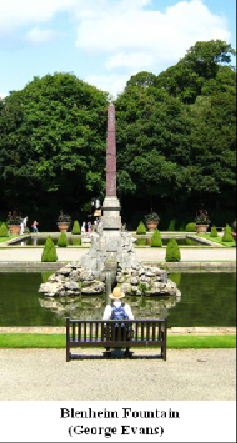 In a strange way, however, it did reach England. In 1710, John Churchill, 1st Duke of Marlborough, acquired a scaled down replica of the fountain and obelisk, begun by Bernini and completed after his death by his workshop, which now stands on the north terrace at Blenheim. You may object that this was only a replica, but so are many souvenirs. If you want authenticity, however, look no further than Dr John Bargrave, travelling tutor to the Grand Tourist John Raymond, who visited Italy in 1646-
In a strange way, however, it did reach England. In 1710, John Churchill, 1st Duke of Marlborough, acquired a scaled down replica of the fountain and obelisk, begun by Bernini and completed after his death by his workshop, which now stands on the north terrace at Blenheim. You may object that this was only a replica, but so are many souvenirs. If you want authenticity, however, look no further than Dr John Bargrave, travelling tutor to the Grand Tourist John Raymond, who visited Italy in 1646-
Until next time,
Ankh Wedja Seneb
Chris
1 Pearce, S. 'Belzoni's Collection and the Egyptian Taste'. In C. Sicca and A. Yarrington eds. The Lustrous Trade: Material Culture and the History of Sculpture in England and Italy, c. 1760-
2 Chaney, Edward 'Roma Britannica and the cultural memory of Egypt: Lord Arundel and the obelisk of Domitian' in Roma Britannica: art patronage and cultural exchange in eighteenth-
June
The corners of a foreign field, that are forever Giza
Come out of Holborn tube station onto Kingsway, and turn left. Walk south for about 150 yards and turn left again into Remnant Street, then follow it until it ends at Lincoln's Inn Fields. The largest of London's garden squares, it is both attractive and impressive, but your immediate reaction would, almost certainly, not be to remark on how similar it is in size to the base of the Great Pyramid at Giza. Yet there is a stubbornly persistent tradition that this is not only the case, but that it was specifically intended to be so.
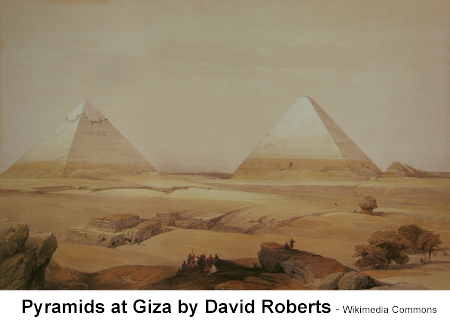
In 1847, a panorama of Cairo was exhibited at the Royal Panorama in Leicester Square. It was painted by the proprietor Robert Burford and his assistant H C Selous from drawings by the artist David Roberts, famous for his series of lithographs of Egypt and Nubia. The pamphlet for this panorama, as well as offering Roberts an opportunity to publicise his forthcoming work, commented that:
€œ”To use a familiar illustration, it [the Great Pyramid] is about the height of St Paul's, and covers a space equal to the area of Lincoln's-
(British Library, Pamphlets collection.)
You might think that this was just a helpful analogy, but nearly twenty years later in 1866 Joseph Bonomi, the artist and pioneer Egyptologist who had become Curator of Sir John Soane's Museum, went so far as to measure the area of the Fields and compare it to the area of the base of the Great Pyramid. London Metropolitan Archives still has his pen and ink drawing on tracing paper which shows the rectangle of the square, with the names of the roads coming into it, and superimposed on it a shaded square outlined in red ink showing the size of the pyramid's base. Neatly written below the diagram is a note "Comparative areas of Gt. Pyramid of Gizeh and the Square of Lincoln's Inn Fields, the red lines indicate the pyramid". Below this is a sum comparing the two areas, and showing the area of the pyramid's base to be greater, and the note "Measured by Joseph Bonomi. Soane Museum. 1866". Bonomi knew Egypt and its antiquities probably as well as anyone of his time, and was also well acquainted with panoramas. While in Egypt with the great Lepsius expedition in 1842 he painted a watercolour panorama of the view from the top of the Great Pyramid, and drawings by him were the basis for Warren and Fahey's moving panorama of the Nile which exhibited at the Egyptian Hall in Piccadilly from 1849. Because of its theme, it is quite likely that he visited the Leicester Square panorama, and purchased the pamphlet accompanying it. So was he simply curious to see if the comparison was true?
Transported bodily to London
 Had this been the case, it is unlikely that it would be mentioned by others. 1877 saw the publication of both Amelia Edward's A Thousand Miles Up The Nile and Erasmus Wilson's Cleopatra's Needle and Egyptian Obelisks, both of which mentioned it. Edwards said that if the Great Pyramid were "transported bodily to London, it would a little more than cover the whole area of Lincoln's Inn Fields" (A Thousand Miles Up The Nile pp. 15-
Had this been the case, it is unlikely that it would be mentioned by others. 1877 saw the publication of both Amelia Edward's A Thousand Miles Up The Nile and Erasmus Wilson's Cleopatra's Needle and Egyptian Obelisks, both of which mentioned it. Edwards said that if the Great Pyramid were "transported bodily to London, it would a little more than cover the whole area of Lincoln's Inn Fields" (A Thousand Miles Up The Nile pp. 15-
€œIn order clearly to realise its [the Great Pyramid's] dimensions, we must imagine the great square of Lincoln's Inn Fields, where the area is exactly that of the Great Pyramid and covering this space we must imagine a mass of stone building the height of the Cathedral at Strassburg.€
(A Handbook of Egyptian Religion P. 117, Griffith's 1907 English translation.)
The tradition was still alive in 1928, when the Architectural Review (Vol. 63, p. 68) commented that most London 'squares' were far from being square. It went on to observe that Lincoln's Inn Fields were more nearly rectangular than most, and:
"still more so when it is further remembered that the commission which laid it out in 1618, and of which Inigo Jones and Francis Bacon were members, would probably have made it a perfect quadrate, had they not for some recondite reason determined that its lines should exactly correspond with the base of the Great Pyramid".
The commission referred to had been set up following a petition to James I in 1617 by the Society of Lincoln's Inn and the four adjoining parishes that the two common fields which came to be Lincoln's Inn Fields should not be built on, but turned into a public space. The monarch was supportive, and in words that have an ironic ring in today's London the Privy Council encouraged the various authorities to proceed with the project:
"as a meanes to frustrate the covetous and greedy endeavours of such persons as daylie seek to fill upp that small remainder of Ayre in those partes with unnecessary and unprofitable Buildinges".
(Survey of London Vol 3 Part 1)
Inigo Jones is believed to have produced plans for laying out the fields into walks, and these seem to have survived in the collection of Lord Pembroke at Wilton House until some time in the 19th century, but to have since been lost. But there is no reason to believe there was anything about them that explicitly suggested a link with the Great Pyramid. So where did the idea come from?
The like dimensions
The answer may lie not in London, but in Wiltshire, and not with the Great Pyramid, but with Stonehenge. In 1620, Inigo Jones was commissioned by James I to study the ruins of Stonehenge, and eventually concluded that it had been built by the Romans. Subsequent antiquarians disputed this view, including John Evelyn who believed it had been built by the Ancient Britons and their Druid priests, and in 1740 the Rev. William Stukeley (a founder member of the first Egyptian Society in London) reasserted this view in his book Stonehenge, a Temple Restor'd to the British Druids. Stukeley, who believed that there were connections between the Druids and the Ancient Egyptians, wrote that:
"the side of the greater pyramid at base, is 693 English feet; which amounts exactly to 400 Egyptian cubits...I have taken notice that Inigo Jones observ'd the like dimensions, in laying out the plot of Lincoln's-
(Quoted by Vaughan Hart, Art and Magic in the Court of the Stuarts p. 134)
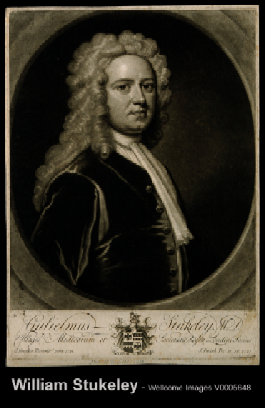 Was Stukeley right to claim that Jones had made this link? We know that Jones travelled to Italy in 1613 in the entourage of the 14th Earl of Arundel, who attempted to buy and bring to England the Obelisk of Domitian now in the Piazza Navona in Rome (see the May issue of this newsletter). We know also that Jones had in his library a number of works on the antiquities of Rome. (See Chaney, reference at end.) These included Andrea Fulvio's Antichità della città di Roma, the works on architecture of Sebastiano Serlio, and Le Cose maravigliose dell'alma città di Roma, a guide to the city for foreign tourists which mentioned both its obelisks and the Pyramid of Cestius. In particular, Book 3 of Serlio's work dealt with Ancient Egyptian architecture, and included material from the Venetian Marco Grimani, who visited Egypt 1535-
Was Stukeley right to claim that Jones had made this link? We know that Jones travelled to Italy in 1613 in the entourage of the 14th Earl of Arundel, who attempted to buy and bring to England the Obelisk of Domitian now in the Piazza Navona in Rome (see the May issue of this newsletter). We know also that Jones had in his library a number of works on the antiquities of Rome. (See Chaney, reference at end.) These included Andrea Fulvio's Antichità della città di Roma, the works on architecture of Sebastiano Serlio, and Le Cose maravigliose dell'alma città di Roma, a guide to the city for foreign tourists which mentioned both its obelisks and the Pyramid of Cestius. In particular, Book 3 of Serlio's work dealt with Ancient Egyptian architecture, and included material from the Venetian Marco Grimani, who visited Egypt 1535-
The job of the commission in which Inigo Jones played a part seems essentially to have been to survey the then current state of the fields, recording what we would now think of as structures or buildings erected without planning permission, and producing proposals for laying them out as a public space, not the overall planning and design of the area and buildings around the fields. In practical terms, it had little if any influence on the subsequent development of the area. In the absence of any firm evidence that Jones intended a link between the dimensions of Lincoln's Inn Fields and the pyramid, it may be more likely that it was Stukeley, considered eccentric even in his own time, who made the link, and believed the Fields to have been created as some sort of symbolic footprint or presence of the Great Pyramid and Ancient Egypt, who thought that behind the sober English feet and inches of London's largest square were corners of a foreign field 400 cubits on a side that would be forever Giza.
Until next time,
Ankh Wedja Seneb
Chris
Chaney, Edward 'Roma Britannica and the cultural memory of Egypt: Lord Arundel and the obelisk of Domitian' in Roma Britannica: art patronage and cultural exchange in eighteenth-
July
Return of the Vegetables from the Tomb…
The April issue of this newsletter, which dealt with the hardy perennials that are Mummy Wheat and Mummy Peas, also briefly referred to an article in The Times of April 25th 1832. Not only is this the earliest reference to mummy vegetables that I have so far come across, but it also introduces another category, that of mummy onions.
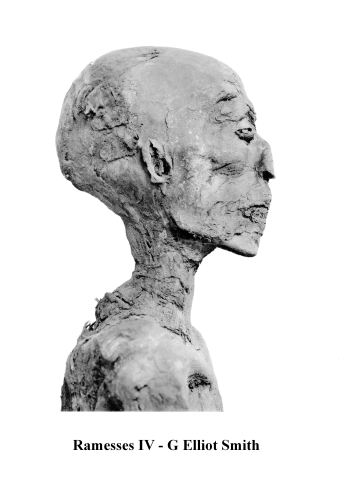 The Times piece can be linked to lectures delivered by George Augustus Rees MD in December 1831 and February 1832 at the Mechanics' Institute (probably the London Mechanics' Institute, which became Birkbeck College), which were later published as Lectures (delivered at the Mechanics Institution, 19th Dec., 1831, and 13th Feb., 1832,) on carbon, oxygen and vitality, the three great agents in the physical character of Man. With remarks on Asiatic Cholera. (The second cholera pandemic had started in 1831, and reached London in 1832.) In the course of these lectures, Rees mentioned a “bulbous root”, almost certainly one of the onion family, found in the hand of an Egyptian mummy, which had allegedly been successfully planted and grown. Onions were not only an important food in Ancient Egypt, and frequently depicted in offering scenes, but their presence in mummy wrappings indicates that they also had religious significance. This may have been because, like the wheat found in Osiris figures in tombs, they had the apparently miraculous ability to regenerate when buried, and also because of their antibacterial properties, which would have been associated with health and vitality. (Part of me can't help thinking of another link. To paraphrase a line from the film Shrek, “Mummies are like onions. They have layers.”) They have been found in the chest and pelvic regions of mummies, against the ears, along legs and on the soles of feet, and, most famously in the case of the mummy of Ramesses IV, in the eye sockets.
The Times piece can be linked to lectures delivered by George Augustus Rees MD in December 1831 and February 1832 at the Mechanics' Institute (probably the London Mechanics' Institute, which became Birkbeck College), which were later published as Lectures (delivered at the Mechanics Institution, 19th Dec., 1831, and 13th Feb., 1832,) on carbon, oxygen and vitality, the three great agents in the physical character of Man. With remarks on Asiatic Cholera. (The second cholera pandemic had started in 1831, and reached London in 1832.) In the course of these lectures, Rees mentioned a “bulbous root”, almost certainly one of the onion family, found in the hand of an Egyptian mummy, which had allegedly been successfully planted and grown. Onions were not only an important food in Ancient Egypt, and frequently depicted in offering scenes, but their presence in mummy wrappings indicates that they also had religious significance. This may have been because, like the wheat found in Osiris figures in tombs, they had the apparently miraculous ability to regenerate when buried, and also because of their antibacterial properties, which would have been associated with health and vitality. (Part of me can't help thinking of another link. To paraphrase a line from the film Shrek, “Mummies are like onions. They have layers.”) They have been found in the chest and pelvic regions of mummies, against the ears, along legs and on the soles of feet, and, most famously in the case of the mummy of Ramesses IV, in the eye sockets.
The “bulbous root” also provides a link to Martin Farquhar Tupper. As you may remember, in June 1843 Michael Faraday read a meeting of the Royal Institution extracts from a note he had received from Tupper describing his allegedly successful planting of mummy wheat. Writing from Brighton, Tupper enthused about his:
“" resuscitated Mummy-
(The Year-
Years later, in the introduction to a biography of Tupper (Martin Tupper, his Rise and Fall by Derek Hudson) his grandson, the Rev. Martin E Tupper, was to recall a jar of mummy wheat in the family house near Crystal Palace in London.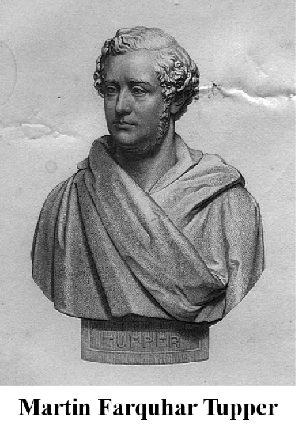
So who was Martin F Tupper? Congratulations if you recognised him as the best selling Victorian author of Proverbial Philosophy, which went through at least forty editions in Britain, and sold nearly one million copies in the United States. Virtually forgotten nowadays, Tupper was a prolific and highly successful author in his time, but the homespun moralising of Proverbial Philosophy, which perfectly suited middle class Victorian tastes, now seems trite and contrived. Among the more than four hundred pages of the book, the section Of Authorship has this to say about the Land of the Pharaohs:
“Egypt, wondrous shores, ye are buried in the sand-
of forgetfulness!
Alas, -
young,
And none durst wrestle with that angel, iron-
bride-
So he flew by strong upon the wind, nor dropped one
failing feather
Wherewith some hoary scribe might register your honour and renown”
His cultivation of Mummy Wheat suggests that Tupper was interested in Ancient Egypt, and indeed he seems to have had a small collection of Ancient Egyptian antiquities, and to have been fairly well read on the subject of Ancient Egypt. Another of his works was A Modern Pyramid: to commemorate a Septuagint of Worthies, sonnets and essays on seventy famous men and women, including the biblical figures of Joseph and Moses. (The original Septuagint were the seventy, or in some sources seventy-
“the hieroglyphical researches of M. Champollion have established that the use of papyrus was long anterior to the age of Moses: there being now extant at Turin an Egyptian writing on papyrus, expounded to be an act of Thutmosis III, and accounted two hundred years older than the time of the Pharaoh, in whose reign Moses flourished.”
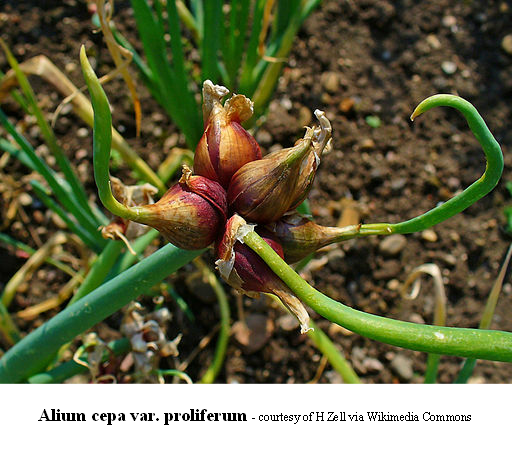
Returning to the topic of Mummy Onions, Tupper must have known of George Rees's lectures, as one of his poems is the rather cumbrously titled On A Bulbous Root (Which Blossomed, After Having Lain For Ages In The Hand Of An Egyptian Mummy). Those of you with the interest and stamina to read all one hundred and thirty-
“What emblem liker, or more eloquent
Of immortality,-
Scarab, or circled snake, or wide-
The azure-
The pyramid four-
Or all whatever else were symbols apt
In Egypt's alphabet,-
So full of living promise?”
However, as I noted in the April newsletter, modern research has shown that the DNA of ancient wheat is so degraded that germination would be impossible, and the same would be true for peas and onions. But while science may seem to have demolished the romantic myth of mummy vegetables, as we know it is remarkably persistent, and before the swift and remorseless passage of the iron-
Until next time,
Ankh Wedja Seneb
Chris
August 2015
Encomia for the Embalmed, or Ditties to the Dessicated
After a positive banquet of mummy vegetables over the last two newsletters, with Mummy Wheat, Peas and Onions, I almost hesitated to return to the subject of mummies again. This time, however, it is the verse that they have inspired, since Martin Farquhar Tupper was (some may say regrettably) not the only author to pen poetry dedicated to the dessicated dead of Egypt.
Significant literary references to mummies in English, as opposed to those in treatises on medicine and other scientific and philosophical works, begin to appear in the seventeenth century. Perhaps the most familiar are those in Shakespeare; Macbeth's “Witches mummy, maw and gulf”, Othello's handkerchief “died in mummy”, and The Merry Wives of Windsor's Falstaff envisaging his drowned corpse as “a mountain of mummy”. There are also references in Webster's The Duchess of Malfi and The White Devil, in the works of Beaumont and Fletcher, Shirley and others, and one of Donne's poems, Love's Alchemy. What all of these shared, however, was that they referred to the commodity of mummy, traded for use by apothecaries.1
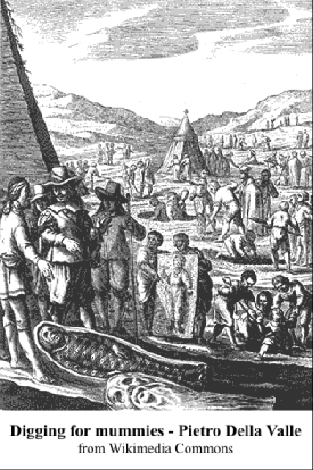 This was understandable, since although people would have been aware of the ultimate source of medicinal mummia, and portions of mummies were kept as curiosities, entire mummies were rare. As an agent for the Turkey Company John Sanderson shipped six hundred pounds of mummy back to England from Egypt in 1586-
This was understandable, since although people would have been aware of the ultimate source of medicinal mummia, and portions of mummies were kept as curiosities, entire mummies were rare. As an agent for the Turkey Company John Sanderson shipped six hundred pounds of mummy back to England from Egypt in 1586-
Literary references to mummies, while still sporadic, continued throughout the seventeenth century, and began to focus more on mummies as preserved people rather than raw material for remedies. John Dryden, in the prologue to his 1668 play Albumazar, a revival of an earlier work by Thomas Tomkis about a celebrated Muslim astrologer, seems to complain bitterly (and perhaps somewhat surprisingly given his use of Tomkis's work) about plagiarists “such authors… as make whole plays, and yet write scarce one word”, complaining that they were worse than highwaymen, since they
“… scarce the common ceremony use
Of, Stand, sir, and deliver up your Muse;
But knock the Poet down, and, with a grace,
Mount Pegasus before the owner's face.”
Even worse, highwaymen
“… strip the living, but these rob the dead;
Dare with the mummies of the Muses play,
And make love to them the Egyptian way; 30
Or, as a rhyming author would have said,
Join the dead living to the living dead.”
Dryden's reference to mummies was still a metaphorical one, but in 1705 the surgeon Thomas Greenhill published his Nekrokedeia, a work on embalming which reflected the religious emphasis of the time on maintaining the body intact for eventual resurrection, and drew on funeral ceremonies and methods of preserving dead bodies from around the world, especially Ancient Egypt. It included an allegorical frontispiece, which Greenhill explained in accompanying verse. In this, he referred to
“Aspiring pyramids, that lift on high
Their spiral heads to reach his kindred sky,
Which in their dark repositories keep
The bodies safe in their immortal sleep;
While healing balm and aromatic spice,
Death's odious dissipation to their form denies.”
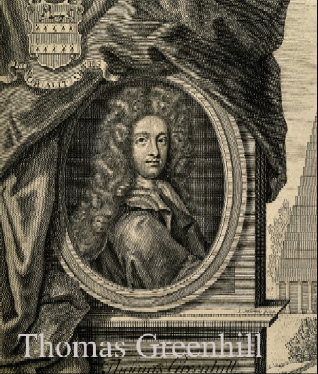 The beginning of the nineteenth century saw Napoleon's expedition to Egypt, and the resulting escalation of contact between Europe and Egypt, and of interest in Ancient Egypt and its surviving artefacts. Not only were more complete mummies, and their coffins, shipped back to Europe, but they began to be exhibited to the general public (at least to those who could afford the entry fees) rather than just a social and cultural elite. One of the earliest, and also most celebrated of these exhibitions, was Giovanni Belzoni's 1821 display of his copies of reliefs from the tomb of Sety I at the Egyptian Hall in Piccadilly, and in a promotional event before this, Belzoni unrolled a mummy. Thomas Pettigrew, who went on to become the mummy unroller par excellence of his day, was present at this, and mentioned it in the introduction to his pioneering A History of Egyptian Mummies, but the event also called to the literary muse in Horace Smith.
The beginning of the nineteenth century saw Napoleon's expedition to Egypt, and the resulting escalation of contact between Europe and Egypt, and of interest in Ancient Egypt and its surviving artefacts. Not only were more complete mummies, and their coffins, shipped back to Europe, but they began to be exhibited to the general public (at least to those who could afford the entry fees) rather than just a social and cultural elite. One of the earliest, and also most celebrated of these exhibitions, was Giovanni Belzoni's 1821 display of his copies of reliefs from the tomb of Sety I at the Egyptian Hall in Piccadilly, and in a promotional event before this, Belzoni unrolled a mummy. Thomas Pettigrew, who went on to become the mummy unroller par excellence of his day, was present at this, and mentioned it in the introduction to his pioneering A History of Egyptian Mummies, but the event also called to the literary muse in Horace Smith.
Horace, and his elder brother James, were the initially anonymous authors in 1812 of Rejected Addresses. Purporting to be a selection of odes unsuccessfully submitted to a competition for an address to be delivered on the reopening of the Theatre Royal, Drury Lane, they were in fact accurate and often amusing parodies of leading poets of the day, including Wordsworth, Coleridge and Byron. Written in only six weeks, the title went through at least fifteen editions, but James only dabbled in literature thereafter. Horace, however, having made a fortune as a stockbroker despite “being from his youth upward better known at Parnassus [home of the Muses] than in the vicinity of the [Stock] Exchange”, in the words of an obituary in The Art-
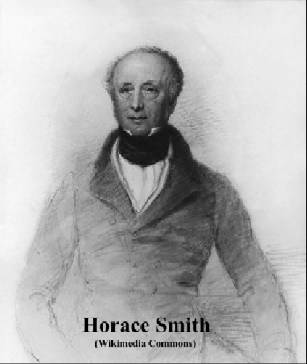 Unsurprisingly, the poem (the full text of which can be read by following the link above to Bartleby.com) is a monologue in which Smith questions the mute mummy on its knowledge of history while alive, both Egyptian and earlier, whether in its tomb it was aware of foreign conquerors, Persian and Roman, and attempts to persuade it to disclose personal details such as its “name and station, age and race” before finally giving up and drawing a suitably pious moral on the pointlessness of preserving the body whilst ignoring the needs of the soul
Unsurprisingly, the poem (the full text of which can be read by following the link above to Bartleby.com) is a monologue in which Smith questions the mute mummy on its knowledge of history while alive, both Egyptian and earlier, whether in its tomb it was aware of foreign conquerors, Persian and Roman, and attempts to persuade it to disclose personal details such as its “name and station, age and race” before finally giving up and drawing a suitably pious moral on the pointlessness of preserving the body whilst ignoring the needs of the soul
“Why should this worthless tegument endure,
If its undying guest be lost for ever?
O, let us keep the soul embalmed and pure
In living virtue, that when both must sever,
Although corruption may our frame consume,
The immortal spirit in the skies may bloom!”
Earlier poets, in the seventeenth century, had used the commodity of mummy as a negative metaphor, its unnatural and unattractive preservation used to suggest that, to adapt Shakespeare's phrase, something was rotten in not only the state but family and personal relationships. In Greenhill's explanation of the frontispiece to Nekrokedeia, a change in emphasis can be seen. He spoke of it illustrating “how mortal man seeks immortality”, but how
“His beauteous frame he sees with speed decline,
And soon dissolved by death, tho' form'd by hands divine”
The reference to plural “hands” was reinforced by numerous other allusions to Classical pagan culture. He speaks of how Man “disdaining death, strives to extend his name”, and of how
“Temples and fanes they to the Godhead raise,
To bribe the only Power, that can destroy, with Praise”
Although in the singular, this can at best be read as an indirect reference to the Christian god, as he goes on to explain how
“Jove pleas'd, in pity of the pious race,
Two messengers sends down the Airy space,
To raise Man's ashes from the silent Urn,
Which touched by Hermes wand resume their pristine Form.
Jove's Royal Bird attends to bear on high,
Th'Immortal Soul up to its Native Sky”
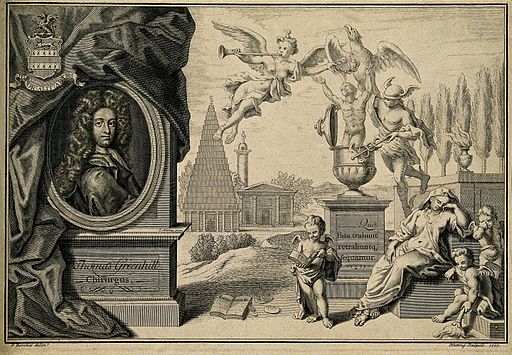
Later poets also tended to concentrate on the preservation of identifiable individuals, but where spiritual survival was mentioned this was more likely to be linked to specifically Christian religious beliefs in judgement and resurrection.2 Addressing his mummy, Smith pronounced
“Thou wilt hear nothing till the Judgement morning,
When the great trump shall thrill thee with its warning.”
At around the same time that Smith was writing, the American poet William Howe Cuyler Hosmer, in The Memphian Mummy, acknowledged that the female mummy who was the subject of his poem “To Apis or to Isis may have prayed”, but still ended by describing its resurrection in recognisably Christian terms
“When the last trump shall animate the tomb,
And call the dead from out the sea and earth -
Maiden, thy spirit will its dust resume,
Far from thy place of birth.”
Whatever their literary merits, all these poems are interesting for their use of mummies as symbols, and for the way that what they symbolise has changed over time. Significantly, one thing all of them have in common is little if any connection to the original role and symbolism of mummies in Ancient Egypt.
Until next time,
Ankh Wedja Seneb
Chris
1. See Schwyzer, Philip 'Mummy is Become Merchandise: Literature and the Anglo-
2. See Day, Jasmine 'The Mummy Speaks' and 'The Maid and the Mummy'.
September 2015
Stanzas on Stones
On Boxing Day 1817, the poet Percy Bysshe Shelley and his wife Mary welcomed Horace Smith to their house at West Street in Marlowe, Buckinghamshire, where he was to be their house guest for several days. Smith was not only a friend of Shelley, but helped to manage the poet's financial affairs. As part of their entertainment over the holiday period, the two men engaged in a poetry competition, in which each had to write a sonnet on a chosen subject within a fifteen minute time limit. (A sort of poetic equivalent of speed chess.) The relatively short fourteen line sonnet form was ideal for this.
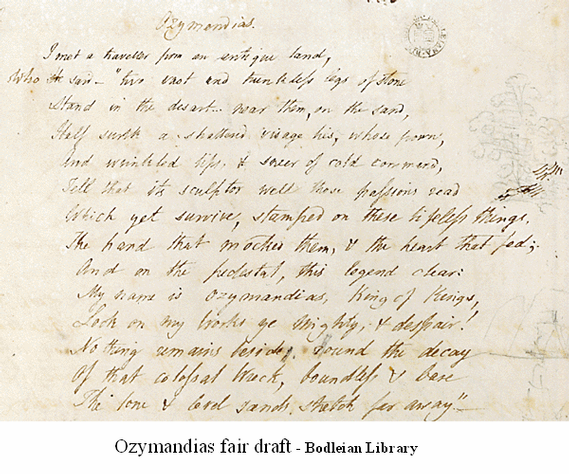
Each of the resulting poems quoted at their beginning, in almost identical form, a passage from the writings of the classical Roman author Diodorus Siculus, which can be taken as their inspiration. The passage was one in which Diodorus described a colossal statue of Ramses II at Thebes, and particularly the inscription on it1
‘I am Osymandyas, king of kings; if any would know how great I am, and where I lie, let him excel me in any of my works.’
(The name, usually spelt as Ozymandias, is generally believed to be a Greek form of the throne name of Ramses II, 'User-
The Younger Memnon
The subject chosen for the poems was a topical one. Interest in Ancient Egypt had been fuelled by the arrival in London in 1802 of Egyptian antiquities, including the Rosetta Stone, and the publication of an English translation of Vivant Denon's account of his travels in Egypt with the French army and of the surviving monuments of Ancient Egypt. Now, the arrival of the so-

The Lover and the Leg
Both poems were published in The Examiner soon after they were written. Shelley's appeared first, on 11th January 1818, under the pen name 'Glirastes'. (Translating as 'Dormouse Lover', this was a private joke, based on his pet name for Mary Shelley 'Dormouse'.) Smith's was published a month later, on 1st February, under the initials 'H.S.'. The Examiner had been founded ten years earlier by John Hunt as a liberal political counterpart to more conservative journals and was edited by his brother Leigh, who knew Shelley well, and introduced him to his fellow poet John Keats. Both poems were also republished, Shelley's in 1819, in his collection Rosalind and Helen, Smith's in 1821 in his Amarynthus. Shelley kept the title Ozymandias. Smith renamed his sonnet On A Stupendous Leg of Granite, Discovered Standing by Itself in the Deserts of Egypt, with the Inscription Inserted Below. It is hardly surprising, given this, that of the two poems it is Shelley's that is best known nowadays. To be fair to Smith, his retitling of his poem may have had an element of irony in it. He and his brother James had come to fame with their Rejected Addresses, parodies of the leading poets of the day, and if his version of Ozymandias lacks Shelley's technical sophistication, its theme and tone are still similar. Leaving aside the relative literary merits of the two poems, however, they are interesting for what they suggest about the way in which Ancient Egypt was perceived at this time.
The Wilderness where London stood
Champollion's final decipherment of hieroglyphs was still several years away, and Classical sources of information on Ancient Egypt, such as Diodorus and Strabo were still of paramount importance. Both poets used the archaic spelling 'desart' for 'desert' in their poems (although it is normally modernised now in Shelley's), which reflected the use of these sources, and the fact that even to their authors Egypt was already ancient, emphasising the antiquity of Egypt. In both poems the statue serves to emphasise the transient nature of temporal power, even for rulers as mighty as the Pharaohs of Egypt, and in Smith's case he speculated that their own civilisation might suffer the same fate as that of the Pharaohs. The choice of topic for the sonnet competition reflected the contemporary interest in Egyptian antiquities, as well as the debate over the rival artistic merits of Greek and Egyptian sculpture, and by extension the respective cultures that produced them. Shelley was soon to leave England, and never returned, but before he did he went on to write a sonnet to the Nile, again as part of a sonnet competition, this time with John Keats and Leigh Hunt, and Smith was also to write Address to the Mummy at Belzoni's Exhibition and To the Alabaster Sarcophagus in 1821, the latter referring to the sarcophagus of Sety I, initially deposited in the British Museum, but now in Sir John Soane's Museum.
Even today, the image of the ruined colossus of Ozymandias still retains its power, and gave its name to an episode of the crime drama Breaking Bad, where the poem was recited in its entirety. Perhaps the last words should belong to Smith and Shelley, however.
Ozymandias
I met a traveller from an antique land,
Who said—“Two vast and trunkless legs of stone
Stand in the desert… Near them, on the sand,
Half sunk a shattered visage lies, whose frown,
And wrinkled lip, and sneer of cold command,
Tell that its sculptor well those passions read
Which yet survive, stamped on these lifeless things,
The hand that mocked them, and the heart that fed;
And on the pedestal, these words appear:
My name is Ozymandias, King of Kings;
Look on my Works, ye Mighty, and despair!
Nothing beside remains. Round the decay
Of that colossal Wreck, boundless and bare
The lone and level sands stretch far away.”
Percy Bysshe Shelley
Ozymandias
IN Egypt's sandy silence, all alone,
Stands a gigantic Leg, which far off throws
The only shadow that the Desart knows:—
"I am great OZYMANDIAS," saith the stone,
"The King of Kings; this mighty City shows
"The wonders of my hand."— The City's gone,—
Nought but the Leg remaining to disclose
The site of this forgotten Babylon.
We wonder,—and some Hunter may express
Wonder like ours, when thro' the wilderness
Where London stood, holding the Wolf in chace,
He meets some fragment huge, and stops to guess
What powerful but unrecorded race
Once dwelt in that annihilated place.
Horace Smith
Until next time,
Ankh Wedja Seneb
Chris
1 See British Library web site 'An Introduction to Ozymandias'
2 James, The British Museum and Ancient Egypt p. 10
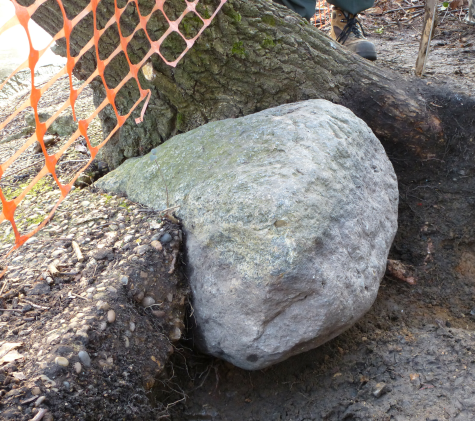












































































































October 2015
Apart from Tony and Cleo…
There are plenty of films that evoke Ancient Egypt, and even Egyptian style cinemas that showed them, but what plays can you think of with an Ancient Egyptian theme? Apart from Shakespeare's Anthony and Cleopatra, of course, and even that was set in late Ptolemaic Egypt. A previous newsletter (August 2015), touched on some plays that mentioned mummy as medicine, but these were isolated references, in plays whose setting and themes were a long way from Egypt. In the late eighteenth century the Theatre Royal Drury Lane hosted The Fall of Egypt by John Hawkesworth, but this was an oratorio based on the biblical account of the Exodus, where the religious message was the focus rather than the culture of Ancient Egypt.
Battles and Bombardments
Unsurprisingly, the catalyst for Egyptian dramas was Napoleon's expedition to Egypt between 1798 and 1801. As early as March 11th 1800, the third incarnation of the Theatre Royal in Drury Lane, London hosted The Egyptian Festival, a three act opera with music by Charles Florio and libretto by Andrew Franklin. It featured choruses of priests, women, and Mamelukes, and according to a contemporary account it concluded with the bombardment of a fort, filling the theatre with suffocating smoke. The scenery was commented on positively, although reviews otherwise seem to have been poor, but the focus seems to have been firmly on topical events, following Nelson's victory at the Battle of the Nile, and anticipating Sir Ralph Abercromby's victory at the Battle of Alexandria. In 1801, Sadler's Wells theatre staged Egyptian Laurels, which included a representation of the Battle of Alexandria, and a musical segment by Charles Dibdin, the songwriter and theatrical entrepreneur who was soon to take over the Wells, entitled Death and Apotheosis of Sir Ralph Abercromby. The great comic actor of his day, Joseph Grimaldi, appeared in it as an Irish character called O’Doody, and compared “English and Egyptian Wonders, including Mamelukes and St Luke’s, Pyramids and Obstacles, Crocodiles and Monopolists, Mummies and Men Milliners, the Fortunes of War and Peace, etc. etc.”. In July 1806, the Wells put on the pantomime Anthony, Cleopatra and Harlequin which seems to have been a revival of an original production in 1803. In it, Grimaldi performed “the Original Mummy Dance”, which he had composed, and there were scenes representing “the Interior of an Egyptian Catacomb, with the tomb of Nilus…the splendid barge in which Cleopatra sailed to meet Mark Anthony [and a] view near Alexandria”. There were also, with the splendid eclecticism of pantomime, scenes set in Greek temples in the Aegean, Lapland (with Grimaldi doing a dance in snow shoes), an English kitchen, a Chinese garden and pagoda, the banks of the River Wye in Herefordshire by moonlight, and a Magic Palace.
Patagonians, Panoramas and Politics
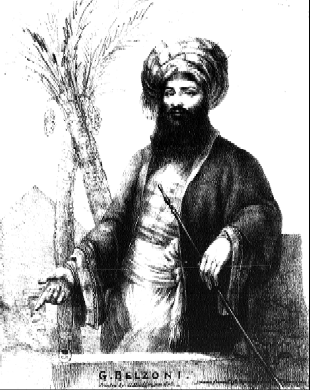 Around the same time, Giovanni Battista Belzoni, later to achieve fame as a traveller and pioneer Egyptologist, was appearing in theatres in London and elsewhere around the country. In early 1804 the Royalty Theatre in Well Street (now Ensign Street) not far from the Tower of London put on its annual pantomime, which that year was called The Egyptian Oracle; or Harlequin’s Punishment. There is no direct evidence that Belzoni was involved in it, although he did appear in other pantomimes, and at this time he was known for his feats of strength as The Patagonian Sampson and theatrical hydraulics, but it is tempting to speculate on how much the enthusiasm for entertainment with an Egyptian theme played its part in influencing the course of Belzoni’s future career.
Around the same time, Giovanni Battista Belzoni, later to achieve fame as a traveller and pioneer Egyptologist, was appearing in theatres in London and elsewhere around the country. In early 1804 the Royalty Theatre in Well Street (now Ensign Street) not far from the Tower of London put on its annual pantomime, which that year was called The Egyptian Oracle; or Harlequin’s Punishment. There is no direct evidence that Belzoni was involved in it, although he did appear in other pantomimes, and at this time he was known for his feats of strength as The Patagonian Sampson and theatrical hydraulics, but it is tempting to speculate on how much the enthusiasm for entertainment with an Egyptian theme played its part in influencing the course of Belzoni’s future career.
A more serious approach to Egypt was taken at the Lyceum Theatre, probably in 1801 or 1802 (sources differ), where Mark Lonsdale's Aegyptiaca was staged. Lonsdale’s production was in three parts, on the Arts, Manners and Mythology of Ancient Egypt, Modern Egypt, and Society and Manners in Modern Egypt. It began with eighteen large pictures based on Vivant Denon’s Description de l’Égypte, and short accompanying descriptions, written and delivered by the writer and diarist John Britton, and was a precursor of the later panoramas of Egypt, especially the Nile Panorama in which Joseph Bonomi was heavily involved. Sadly, in the words of the nineteenth century playwright and theatre historian Charles Dibdin Jr., “…from its possessing a character too chastely classical to become popular, it entirely failed of success.” and Lonsdale was ruined. Even the more successful Nile Panorama, exhibited in 1849 in the Egyptian Hall in Piccadilly, was to encounter financial problems, and the overall emphasis on theatrical treatments of Egypt was firmly focussed on entertainment.
1811 saw the first London production at the Haymarket Theatre of Mozart's The Magic Flute, with its Masonic and Egyptian elements, but a fantasy setting. More firmly connected to Egypt was an 1817 production at the Theatre Royal Drury Lane, “A New MUSICAL DRAMA in three acts which has been long in preparation, called ELPHI BEY: or, The ARAB’S FAITH”, written by Ralph Hamilton, with music by Thomas Attwood (a pupil of Mozart’s) and others. Hamilton’s introduction credited Henry Salt, British Consul in Egypt at the time, for the story that inspired it, and Salt's illustrations to Viscount Valentia’s Voyages and Travels… to Egypt as the principal inspiration for the scenery. It was even described by Hamilton as a “joint composition”, although there is no direct evidence that Salt wrote any of it.
 The story was a romanticised version of an incident involving Elphi Bey recounted in Valentia's book, which took part during the long and complex civil war in Egypt resulting from the power vacuum created by the French defeat at the Battle of the Pyramids of the Mamelukes, the ruling military caste of Egypt at that time. Elphi (or Elfi) Bey, more properly Muhammed Bey al-
The story was a romanticised version of an incident involving Elphi Bey recounted in Valentia's book, which took part during the long and complex civil war in Egypt resulting from the power vacuum created by the French defeat at the Battle of the Pyramids of the Mamelukes, the ruling military caste of Egypt at that time. Elphi (or Elfi) Bey, more properly Muhammed Bey al-
Mummies and Monotheism
These early nineteenth century productions can be attributed to the general enthusiasm for all things Egyptian in the Regency period, but, even if they were not numerous, such entertainments continued to occur beyond it. In 1824, the Theatre Royal Covent Garden staged Charles Farley's The Spirits of the Moon; or the Inundation of the Nile, and in 1833 William Bayle Bernard's one act farce The Mummy entertained audiences at the Adelphi Theatre in the Strand with a lover in disguise, an actor pretending to be a mummy, his father selling a real mummy, the Elixir of Life rediscovered by the beloved's father, a bottle of brandy, a sarcophagus, switched labels and confusion between them all with, as the time-
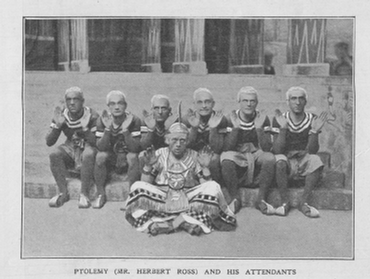 The turn of the Twentieth Century saw the New and Criterion Theatres play host to Amasis: an Egyptian Princess, a comic opera in two acts, based on a passage from the writings of Diodorus Siculus about a Roman lynched for killing a cat in Egypt. The action sees the poor scribe Cheiro, in love with Princess Amasis, condemned to death for confessing to killing a sacred cat actually killed accidentally by the princesses's suitor Prince Amhotep. Eventually, Cheiro is saved by the princess, the lovers united, and the scheming Court Embalmer and Private Secretary to Pharaoh, Ptolemy Theopompus Allakama, who has plotted to kill Amhotep to inherit his wealth, is mummified in his own patent embalming machine. Among its delights were a dance by “Mummy Guards”. Romance and adventure, rather than mummies, seem to have been the key elements of Secret Egypt, staged in 1928 at the Q Theatre at Kew Bridge. It was co-
The turn of the Twentieth Century saw the New and Criterion Theatres play host to Amasis: an Egyptian Princess, a comic opera in two acts, based on a passage from the writings of Diodorus Siculus about a Roman lynched for killing a cat in Egypt. The action sees the poor scribe Cheiro, in love with Princess Amasis, condemned to death for confessing to killing a sacred cat actually killed accidentally by the princesses's suitor Prince Amhotep. Eventually, Cheiro is saved by the princess, the lovers united, and the scheming Court Embalmer and Private Secretary to Pharaoh, Ptolemy Theopompus Allakama, who has plotted to kill Amhotep to inherit his wealth, is mummified in his own patent embalming machine. Among its delights were a dance by “Mummy Guards”. Romance and adventure, rather than mummies, seem to have been the key elements of Secret Egypt, staged in 1928 at the Q Theatre at Kew Bridge. It was co-
Theatre is about many things, but ultimately it can be argued that even 'serious' theatre is about entertainment in the widest sense. While these plays may tell us little about Ancient Egypt, and what they do tell us is seldom accurate, they do tell us a lot about our perception of it. Topical productions, especially spectacular ones, are popular but by definition largely about the Egypt of their day. What keeps appealing to audiences is not real Ancient Egypt, but fantasy Egypt, a land of monuments, magic, mummies, and the mysterious Queen Cleopatra. Which means, of course, that we cannot forget the fantasy Moorish style Alhambra Theatre and others which were the setting from the late 1920s to the early 1960s for Cleopatra's Nightmare and the Sand Dance of the immortal Wilson, Keppel and Betty.
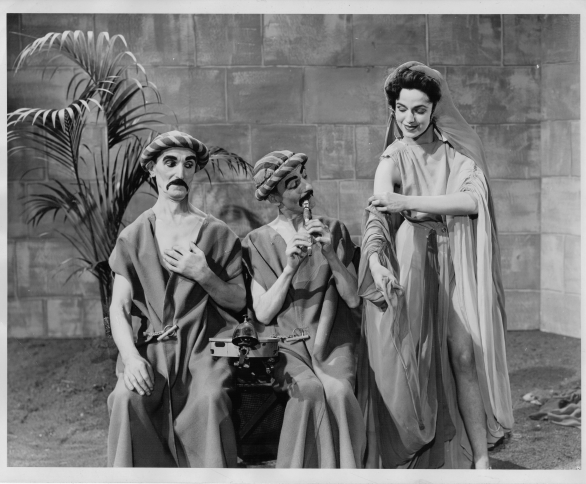
Until next time,
Ankh Wedja Seneb
Chris





















November
Against the Grain
“My own personal theory is that Joseph built the pyramids in order to store grain”.
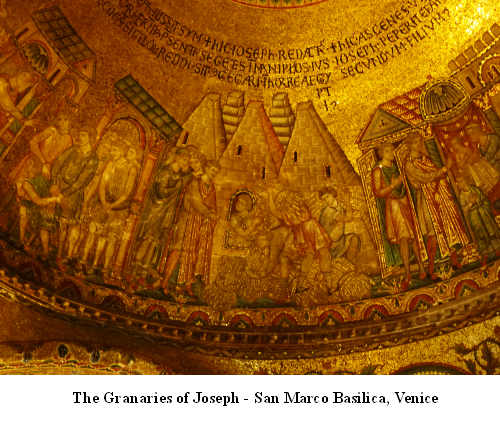
The opening words of a video clip from a speech by the US presidential candidate Ben Carson, and ones which did little to help his campaign. To be fair, the speech from which it was taken, to graduating students at Andrews University in Michigan, had been made nearly eighteen years before, in 1998, but when he was contacted by CBS News, after the clip had been posted by the Internet news site Buzzfeed on 4th November 2015, he confirmed that “It's still my belief, yes.”1 Even Daniel Weber, a spokesman for the Seventh Day Adventist Church of which Carson is a member, described the theory as “his [Carson's] own interpretation [of biblical scripture]”.2 Now, there have been plenty of Egyptologists to explain, as patiently and positively as they can manage, on exactly what basis they believe that the Egyptian pyramids were funerary rather than agricultural in function, so that's not what this issue of the newsletter is about. It's not even about the views of Dr Carson. He is welcome to believe whatever he likes, as long as he doesn't try to impose those views on others, and he did emphasise that it was a personal belief. Rather, it is a response to the surprising comments with which the Adventist spokesman Daniel Weber followed his metaphorical swift step back from Carson's views. Weber went on to say:
“Of course we [Seventh Day Adventists] believe in the biblical account of Joseph and the famine, but I've never heard the idea that pyramids were storehouses of grain.”
This is a bit surprising, given how far back belief in the Pyramids of Giza as the Granaries of Joseph goes. In an article on the BBC web site3, Professor John Darnell, of Yale University, refers to the thirteenth century mosaics in the narthex of the Basilica of San Marco in Venice which illustrate the biblical story of Joseph and his brothers, and show the Pyramids as granaries. The article goes on to quote the 6th century AD St Gregory of Tours, who wrote:
“And on its [the Nile's] bank is situated, not the Babylonia of which we spoke above, but the city of Babylonia in which Joseph built wonderful granaries of squared stone and rubble. They are wide at the base and narrow at the top in order that the wheat might be cast into them through a tiny opening, and these granaries are to be seen at the present day.”4
Gregory spent his life in what is now France, and so could not have written from first-
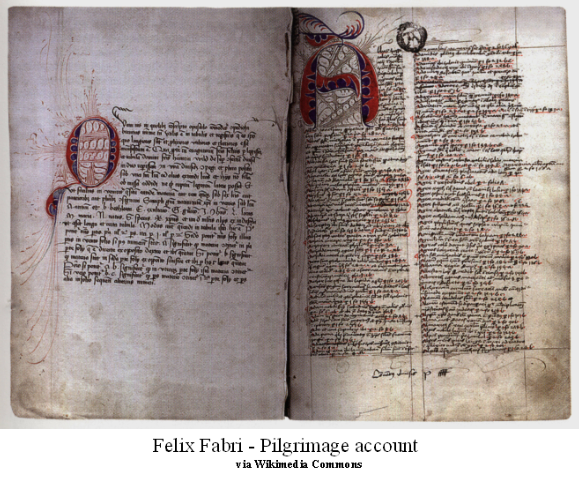
Pilgrims and Pharaohs
Darnell notes that "If you didn't have access to the structures, the idea [that they had been built as granaries] had some currency." Interestingly, even when people did have access to them, the belief was not dispelled. It was probably most popular during the Middle Ages, and an important factor in this was the influence of pilgrimage to the Holy Land, via Egypt. The earliest account by a pilgrim mentioning the pyramids as the granaries of Joseph seems to be that of Egeria, in the late 4th century AD. Little is known for certain about her, and the portion of her text covering Egypt only survives in a 12th century summary, but she seems to have been Spanish. The late 13th century Hereford Mappa Mundi, showing the world as it was perceived at that time, probably drew on 5th century sources, and includes a number of sites and features in Egypt, including the pyramids, described as Joseph's Barns. In the early 14th century, the Irish Franciscan Symon Semeonis undertook a pilgrimage to the Holy Land with his companion, the splendidly named Hugo Illuminator, who sadly was to die of dysentery in Cairo. Symon's account again describes the Giza pyramids as the three barns of Joseph. Another source describing them in the same way is the Travels of Sir John Mandeville, which began to circulate in the second half of the 14th century. However, there are doubts as to whether he actually existed, or was simply created as the 'author' of a work based on passages from other authors. Far more credible is the account of their pilgrimage by Frescobaldi, Gucci and Sigoli, three members of a group of thirteen Tuscans and their seven servants who left Florence on pilgrimage to the Holy Land in 1384. Gucci describes their visit to Giza, and the “granaries of Pharaoh” in some detail, saying that there are fifteen pyramids in an area of about twelve miles, and that they are in groups of three. His group measured one pyramid, by pacing the distance or measuring with a stick, and also went inside it.
Silos or Sepulchres?
Darnell is quoted in the BBC article as saying that the idea of the pyramids as the Granaries of Joseph began to fall out of favour during the Renaissance, when more detailed studies of them began to be made. In fact, assuming the Renaissance to have begun in Italy around 1350, there had been sceptics long before this. In the late 6th and early 7th century AD, St Isidore of Seville viewed the pyramids as places of burial, and Hrabanus Maurus, Archbishop of Mainz in the late 8th and early 9th centuries, expressed the same view.6 The German Dominican Wilhelm von Boldensele, who travelled to Egypt in the first half of the 14th century, expressed his doubts that the pyramids could have been granaries, and another Dominican, Felix Fabri of Ulm, who made two pilgrimages to Egypt in the 15th century, entered the Great Pyramid, and commented on the lack of space inside it. It was certainly not the case that the idea of the pyramids as the Granaries of Joseph was uncritically accepted until the beginnings of modern scientific investigation, but the tradition linking Joseph and the pyramids was a remarkably resilient one, and as late as the first half of the 15th century, when the Castilian traveller Pero Tafur visited Egypt, he not only referred to the Pyramids of Giza as the Granaries of Joseph, but described how he believed they had been used
“The next day we went to see the Granaries of Joseph, which are three leagues from the mouth of the river, in the desert. Although they say that there are many more further inland, there are only three here, two great ones, and one lesser one. As one enters through the door there is a wall joined to another, making a circular stairway which reaches to the top, with many windows. And the beasts, when they are laden, climb up and are unloaded through those windows, and so they fill the granaries to the top.”7
It is difficult to reconcile this description with the Great Pyramid, most likely to be the one referred to (it is believed to have been opened in the 9th century AD), and overall it seems strange that while authors who had not seen the Pyramids could accept that they might have been royal tombs, travellers who had seen them, and even entered one, could apparently fly in the face of logic and maintain that they had been constructed as granaries.

Travellers' Tales
One explanation for this is that not all the accounts can be taken at face value. Certainly this is the case with Sir John Mandeville, who may have been invented to link together a collection of accounts from other authors, but even the account of a historical figure like Arnold von Harff, who visited Egypt in the late 15th century, can be problematic. Not only is his treatment of dates haphazard, but his claims to have climbed the Mountains of the Moon, visited the source of the Nile, and travelled back down it to Cairo are clearly fantasy. Pilgrimages to Egypt were costly and risky, with deaths among pilgrims common, but offered the opportunity to acquire the status, and the religious benefits of indulgences, that went with having visited its holy and secular sites. Practical issues of cost, time, and security may often have meant that some could not be visited, or were only seen briefly or from a distance, but the temptation on returning home to embroider the truth or even invent it must often have been powerful. Another factor is the effect of what is sometimes called Received Authority Syndrome. Father Eugene Hoade, one of the translators of the accounts of Frescobaldi and the other Tuscan pilgrims, observes of the account of Symon Semeonis that many things in it
“are the silly talk of guides, from which the Holy Land and the adjoining countries have always suffered”8
Nonetheless, much of this has always been accepted by travellers, on the basis that the guides are local experts. Gucci noted that the 'granaries' were said to have been made by Pharaoh at the time of Joseph and the great famine in Egypt, but also expressed his opinion that
“to see them they appear to be works for perpetual memory rather than granaries”9
Von Harff, similarly, was told by his Mameluke guides, while they were eating lunch after having climbed the Great Pyramid, that 'King Pharaoh' had built them to store grain, but noted that some said that they were the tombs of the old kings of Egypt. However, for every sceptic, there must have been many more believers. The accounts of Frescobaldi, Gucci and Sigoli are valuable not least because they enable us to compare accounts by different people on the same pilgrimage, and while Gucci noted his doubts, Frescobaldi simply records the pyramids as thirteen granaries which Joseph had made in the days of famine, and Sigoli, after describing the three Giza pyramids and their huge size, says that the corn was placed inside them, and observes wonderingly
“just imagine the very great amount that inside would take”10
We can give them the benefit of the doubt and assume that none of them entered the Great Pyramid, or that if they did they they assumed that they had only seen a portion of its vast interior, but over six hundred years later, after all that has been learned about it, Ben Carson could still say
“it would have to be something awfully big… to store that much grain, and when you look at the way in which the pyramids are made, with many chambers that are hermetically sealed, they would have to be that way for a reason.”
Ultimately, many pilgrims saw perhaps not so much what they wanted to see, as what they believed they would see. For them, the biblical account of Joseph, the famine in Egypt and the stores of grain were matters of faith. The biblical narrative is not specific (the King James version simply refers to food being laid up “in the cities” and “storehouses” being opened), and it would not be contradicted by assuming that this was done in many ordinary granaries. The story was not one of prudent planning and management of food stocks, however, but of miraculous prophecy revealing the will of God. The pyramids, and particularly the Great Pyramid, the only one of the Seven Wonders of the Ancient World to survive, were suitably impressive structures to associate with this, and were also surviving evidence of the power and splendour of Ancient Egypt, testified to in the Bible. It is not difficult to see why many pilgrims chose not to examine what they were told too closely, and why the urge to see the pyramids as the Granaries of Joseph still endures.
Until next time,
Ankh Wedja Seneb
Chris
1. http://www.buzzfeed.com/natemcdermott/ben-
2. http://nypost.com/2015/11/05/ben-
3. http://www.bbc.co.uk/news/magazine-
4. http://legacy.fordham.edu/halsall/basis/gregory-
5. Edwards, The Pyramids of Egypt p. 295, Hornung, The Secret Lore of Egypt p. 155, and Iversen, The Myth of Egypt and its Hieroglyphs in European Tradition p. 59.)
6. Hornung, The Secret Lore of Egypt p. 155.
7. Letts, Malcolm, trans. & ed. The Pilgrimage of Arnold von Harff London, Hakluyt Society 1946
8. Hoade, Western Pilgrims Jerusalem 1970
9. Ibid, p. 104
10. Ibid, p. 169
December
'Tis The Season…
To curl up in front of a roaring cliché with a good book, and what better than a classic detective story?
There has been plenty of fiction inspired by Ancient Egypt, including romances of reincarnation like Rider Haggard's She and Bram Stoker's Jewel of the Seven Stars, and plenty of stories of the dessicated dead in the many mummy tales, but all these have in common an element of the occult. Egyptology, however, is a science, and so we should also expect some fiction to excite the intellect as well as raise the hairs on the backs of our necks. With that in mind, this issue of the newsletter looks at the somewhat specialised field of detective fiction with an Ancient Egyptian flavour.
Detect the Halls
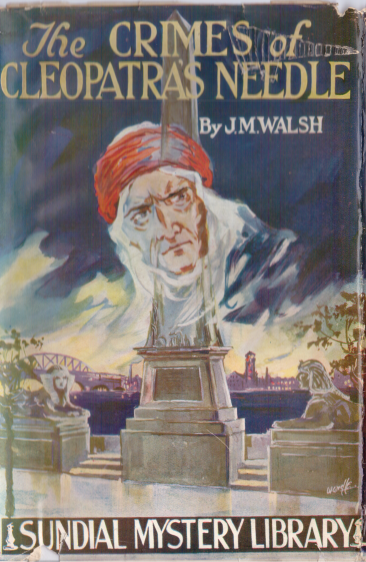 Starting in London, a relatively early effort in the genre is 1928's The Crimes of Cleopatra's Needle by J M Walsh, an Australian born author who emigrated to London in his late twenties. He wrote under his own name, and also used the noms de plume of H Haverstock Hill, Stephen Maddock and George M White, publishing at least fifty-
Starting in London, a relatively early effort in the genre is 1928's The Crimes of Cleopatra's Needle by J M Walsh, an Australian born author who emigrated to London in his late twenties. He wrote under his own name, and also used the noms de plume of H Haverstock Hill, Stephen Maddock and George M White, publishing at least fifty-
Also with a London connection is a 1929 short story by that colossus of crime writing Edgar Wallace, A Priestess of Osiris. Set in London and Jerusalem, it is a tale of deceit and murder featuring Mrs Sophia Baffleston, Durr the Carpenter (Mahmet el Durr), and Ahmed Hafiz, a fake medium. (There is also the curious connection that one of the locations in the story, Torrington Square, was where Flinders Petrie lived for a time, and Petrie died in Jerusalem.)
These were by no means the earliest such stories, though, and there is no sign of the genre running dry. Thanks to the heroic efforts of Noreen Doyle and others, the Ancient Egypt in Fiction bibliography web pages have a section on investigation and the Land of the Pharaohs, tracking titles from as early as 1897 up to 2009:
Ancient Egypt in Mysteries and Thrillers
A lot of these titles, however, are difficult to come by, and, to put it as politely as possible, of varying quality. Those in search of guaranteed sleuthing satisfaction looking to the great names of the golden age of detective fiction will find that they are not disappointed.
Call in the professionals
The Eye of Osiris is one of R Austin Freeman's Dr Thorndyke mysteries, written in 1911. Once again, we are back in London, in the British Museum itself, with not only mummies, but one of them, that of Artemidorus, having a part in the novel. Without giving too much away, suspects are incriminated by a trail of body parts planted around London, and the protagonist's background as a lecturer in forensic medicine enables him to use what was then cutting edge technology to solve the mystery.
Another well-
For real hard core Egyptological investigation, however, you need the input of professionals, which leads us to the Queen of Crime, Agatha Christie. Her first detective story with Egyptian elements, The Adventure of the Egyptian Tomb was written in 1924, but after 1930 she had the advantage of being married to a real archaeologist, Max Mallowen. Think of Christie and Egypt, and you think of Death on the Nile, of course, but for Death Comes as the End, which was inspired by the genuine Ancient Egyptian correspondence of Heqanakhte, she owed a great deal to the advice of her friend, the Egyptologist Stephen Glanville, who conveniently lived in the same block of flats. Fourteen years before, and on the other side of the Atlantic, however, the art critic Willard Huntington Wright, also advised by Egyptologists, had gone one better than Christie. Writing under the nom de plume of S S Van Dine his novel The Scarab Murder Case features a museum, murder (and attempted murder) with Egyptian antiquities, and actual hieroglyphic texts.
WARNING! The rest of this newsletter contains possible plot spoilers written in hieroglyphs.
Murder in the Museum
 One of Van Dine's Philo Vance mysteries, its dedication credits Ambrose Lansing, Ludlow Bull and Henry A Carey of the Egyptian Department of the New York Metropolitan Museum of Art, and their input is evident in the book, although they cannot be held responsible for what is done with it. The story begins, and most of it takes place, in the private museum of Egyptian antiquities in New York of the Egyptologist Dr Mindrum Bliss, which is supported by the philanthropist and art patron Benjamin H Kyle. Bliss is said to have taught Egyptology at Harvard, and have worked with the genuine Egyptologist Arthur Weigall. (Suggesting that Wright/Van Dine may have known Weigall.) Bliss's 'publications' are detailed in a footnote, and another discusses different Egyptological schools of thought (“Bliss-
One of Van Dine's Philo Vance mysteries, its dedication credits Ambrose Lansing, Ludlow Bull and Henry A Carey of the Egyptian Department of the New York Metropolitan Museum of Art, and their input is evident in the book, although they cannot be held responsible for what is done with it. The story begins, and most of it takes place, in the private museum of Egyptian antiquities in New York of the Egyptologist Dr Mindrum Bliss, which is supported by the philanthropist and art patron Benjamin H Kyle. Bliss is said to have taught Egyptology at Harvard, and have worked with the genuine Egyptologist Arthur Weigall. (Suggesting that Wright/Van Dine may have known Weigall.) Bliss's 'publications' are detailed in a footnote, and another discusses different Egyptological schools of thought (“Bliss-
Let's not forget, however, that there is a murder investigation going on as well. Kyle is found in the museum, bludgeoned to death with a two foot long statue of Sekhmet, and from that point on the clues and red herrings come thick and fast. The first of these is a scarab of the Pharaoh Intef, mounted as a scarf pin. (The treatment of Egyptian antiquities throughout the story, it has to be said, is alarmingly cavalier.) Vance reads the cartouche on it as “Nisut Biti… Intef-
“No art expert can tell with surety who drew a picture – and Egyptian writing is mostly pictures… The only approach in such matters is an aesthetic one – and there are no aesthetics in Egyptian hieroglyphs. Furthermore, everyone around here used the Erman-
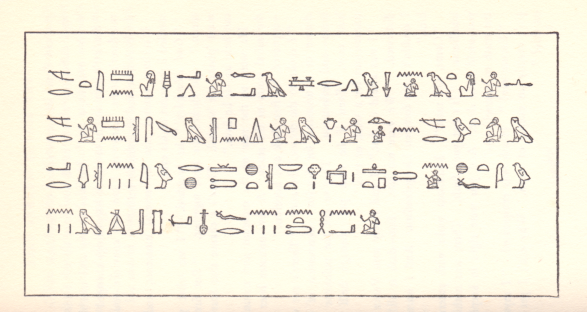
The view of Egyptologists, then and now, might be different. (Interestingly, the hieroglyphs in the Wörterbuch are drawn by hand, like those in Faulkner's Concise Dictionary of Middle Egyptian, while those illustrated in The Scarab Murder closely resemble the 'Gardiner' font, familiar from Egyptian Grammar.)
Who killed Kyle? If you fancy finding out for yourself, The Scarab Murder Case is still in print as part of a Philo Vance collection, and also available in e-
And finally, it wouldn't be Christmas without the sort of jokes that you find in crackers, and so I leave you with one from a number of years ago that I picked up during my research.
Small child to parent in museum “That mummy must have been run over by a motor car.”
Parent “How can you tell?”
Child “It's got the registration number of the car on the label – BC 1750”
Until next time,
Ankh Wedja Seneb
Chris
With thanks to the Classic Crime Fiction web site for background information on Walsh.


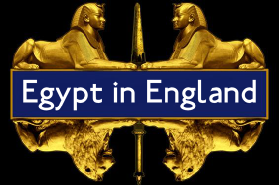
| The Elderly Lady's Elephant |
| Murder, Mystery, Monuments and Mummies |
| Necropolis of the North West |
| Picture This |
| Newsletter subscription form |
| Egypt in England Newsletter 2016 |
| Egypt in England Newsletter - 2015 |
| Egypt in England Newsletter 2014 |
| Egypt in England Newsletter - 2013 |
